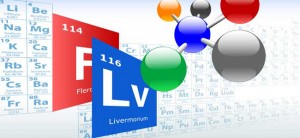All of the elements around 116 are so fragile and exist for such a short period of time that you can't really study them the way you can study carbon, or gold, or other elements. We do know it has 116 protons, and based on how the periodic table works, it should have properties much like polonium, the element right above it on the table (a highly toxic metal, incidently, because it's so radioactive). But beyond that it's speculation.
JON BROOKS: When's the last time a periodic table element was added?
SAM KEAN: Ha, well, that actually sort of depends on what you mean. The last new new element - that is, the last element that no one had ever even claimed to have seen before, and so filled in a missing space on the periodic table, was element 117, announced in April 2010.
The last new official elements - that is, an element where the international chemistry community had looked over the experimental results and given their approval - was with elements 114 and 116.
The difference is this: again, these elements are extremely fragile and scientists find so little of them - just six or so atoms for element 117, for instance - that it's really, really hard to even tell that the element even exists.
In some ways, in fact, it's less a straight scientific judgment than something like a Supreme Court ruling: The best chemistry minds out there have pored over the data and pronounced that it existed, therefore it does. Their judgment has word of law almost, because these experiments are so hard to repeat. And it sometimes take a decade or more to win official approval.
JON BROOKS: How common is it to name elements after people or places?
SAM KEAN: Fairly common. We actually saw examples of both recents trends with element naming with this pair - naming them for famous scientists and naming them to honor places where elements were discovered. Or at least, in the Livermore case, where scientists were helping out to discover them.
I'm actually pretty surprised that Livermore got the nod for 116, since the rumor was that the scientists would name the element moscovium, to honor Moscow, considering that the work was done on Russian soil. Oh, and as you probably know, both California and Berkeley have elements named after them, so Livermore is joining some fine local company.
JON BROOKS: Anything else we should know?
SAM KEAN: It's too bad, I think, that livermorium couldn't have been element 114 instead of 116. Making it 114 would have put it in the same column on the table as silicon, the element that made California's tech industry. There would have been a nice harmony to that, but considering how precious the real estate is on the periodic table, you take what you can get!
